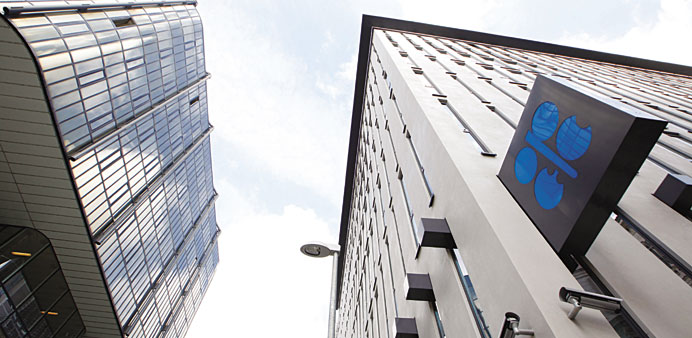A view of the Opec headquarters in Vienna. Opec crude production rose above its target for the first time in five months as Iraq pumped the most in 35 years, according to the IEA.
Opec crude production rose above its target for the first time in five months as Iraq pumped the most in 35 years, according to the International Energy Agency.
The 12 members of the Organisation of Petroleum Exporting Countries produced 30.49mn barrels a day in February, up from 29.99mn in January, the Paris-based IEA said yesterday in its monthly oil market report. That’s about 300,000 barrels a day higher than the average level required in the second half of the year, according to the agency.
Iraqi crude output jumped by 530,000 barrels a day to 3.62mn, driven by upgraded infrastructure in the country’s southern oil-producing region and the reduction of bottlenecks at its Gulf export facilities. That was the highest since 1979. Exports soared by 572,000 barrels a day to 2.8mn.
“The exceptional increase in February’s exports has been an unexpected boost for the country, which has struggled to meet production targets,” the IEA said. “Increased export capacity and the start-up of new production in the south holds the promise of higher output this year.”
Opec, which supplies about 40% of the world’s oil, estimated that its members produced about 30.12mn barrels a day last month, as Iraq compensated for reductions in Libya and Saudi Arabia, according to a report by the group yesterday based on secondary sources. Output was the most since August.
Saudi Arabia raised production to 9.85mn barrels a day in February versus 9.76mn in the previous month, the IEA said, reflecting increased demand from the nation’s new 400,000 barrel-a-day Jubail refinery.
Libya pumped an average 360,000 barrels a day last month versus 500,000 barrels a day in January. “Unrest and protests by separatist militias seeking a greater share of the country’s oil wealth and disgruntled ethnic groups have held hostage the country’s eastern production for eight months against a backdrop of a weak and battered central government,” the IEA said. “The latest developments put in further doubt a recovery in Libya’s oil production near-term.”
Meanwhile, global imports of Iranian oil hit a one-year high in January and February, the IEA said, a trend industry sources say suggests an easing of sanctions pressure on Tehran is helping its exports to recover.
Imports of Iranian crude, including condensate, reached 1.41mn barrels per day (bpd) in January and February, the IEA, which advises industrialised countries, said in a monthly report. The IEA revised up January’s figure by 90,000 bpd.
“Higher Iranian imports in recent months reflect, in large part, increased sales of condensates to Asian buyers,” the Paris-based agency said. “Imports of Iranian oil surged in Japan and South Korea, albeit from exceptionally low January levels.” The rise in shipments follows an interim deal agreed in November with world powers in return for curbs on Iran’s nuclear programme. This, oil traders and industry sources say, has improved sentiment and reduced uncertainty for buyers.
Opec’s members are Algeria, Angola, Ecuador, Iran, Iraq, Kuwait, Libya, Nigeria, Qatar, Saudi Arabia, United Arab Emirates and Venezuela. The group, which has a collective target of 30mn barrels, will next meet to review the limit on June 11 at its headquarters in Vienna.

